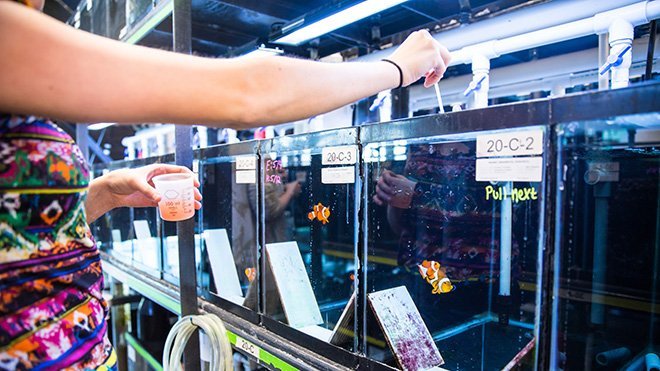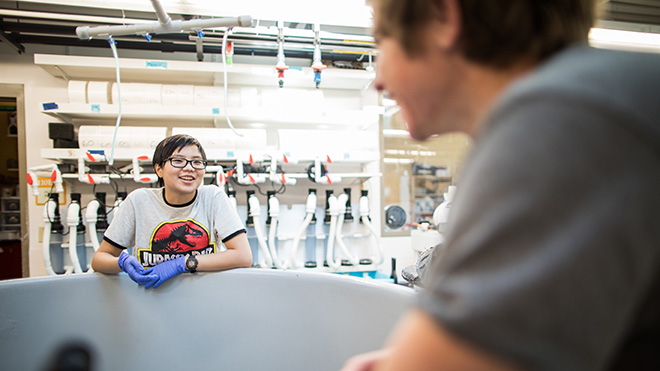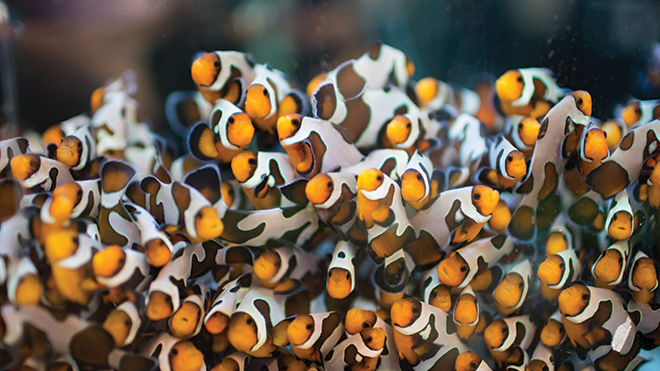RWU and New England Aquarium Team Up to Advance Marine Fish Aquaculture and Conservation at U.S. Public Aquariums
With a $750,000 NOAA Sea Grant, NEAq and RWU lead initiative to catalyze sustainable breeding and raise awareness of aquaculture among public and commercial fishermen

BRISTOL, R.I. – Leveraging a longstanding partnership of successfully rearing saltwater fish species for public display, the New England Aquarium (NEAq) and Roger Williams University (RWU) will lead an effort to expand their pioneering aquaculture efforts, partnering with major public aquariums across the U.S.
The National Oceanic and Atmospheric Administration (NOAA) awarded a $750,000 NOAA Sea Grant to the New England Aquarium, Boston; Roger Williams University, Bristol, R.I.; Aquarium of the Pacific, Long Beach, Calif.; John G. Shedd Aquarium, Chicago; National Aquarium, Baltimore, M.D.; the North Carolina Aquariums (Pine Knoll Shores, Roanoke Island at Manteo, and Fort Fisher at Kure Beach); and the University of Massachusetts Boston; to develop aquaculture programs for rearing and propagating marine fish that are already part of extant exhibitions at the partner institutions. NEAq and RWU have played a leading role in helping public aquariums develop and refine animal collection programs to enhance the sustainability of collections through aquaculture and ethical wild fisheries.
Through a knowledge and technology transfer from NEAq and RWU’s program, the initiative aims to build capacity for sustainable breeding of species that are important to public aquariums and may also be of interest for aquaculture development to commercial fisheries. Additionally, the partnering aquariums will share propagation strategies with other institutions looking to develop similar programs and educate the public about aquaculture through interactive storytelling exhibitions, growing the knowledge of marine fish aquaculture and increasing the commercialization of species studied.
“Aquariums have a unique opportunity to connect our visitors with animals and aquaculture through our exhibits. Knowing that animals are acquired ethically, responsibly and sustainably, is crucial for aquariums and important to our guests,” said Barbara Bailey, Curator of Husbandry and Sustainability at the New England Aquarium. “This grant will accelerate and catalyze the larval work that has been happening at the New England Aquarium and Roger Williams University for years. It will also allow the partner institutions to expand that work at their facilities.”
Since 2008, NEAq and Roger Williams University have partnered on sustainable breeding of important marine fish species for exhibition – including many for the first time ever – joining forces to propagate fish in the university’s WetLab and drawing on RWU’s leadership in aquaculture science and student research and work experience opportunities. The NEAq/RWU partnership has successfully raised more than 17 species from egg to adult, such as the queen trigger, blue chromis, brown chromis and copper sweeper.
“This collaboration is an outgrowth of the unique partnership Roger Williams University has with the New England Aquarium, expanding our innovative aquaculture program to build capacity for sustainable marine fish breeding at multiple institutions and scaling it up to a national scope,” said Andrew Rhyne, professor of marine biology at RWU and NEAq research scientist. “Aquariums have huge numbers of visitors and aquaculture is rising in importance as a source of food and employment across the country, so it’s a great time for the public to understand the benefits of aquaculture and how it can be done responsibly and sustainably.”

The goal of this partnership, in collaboration with the Woods Hole Sea Grant and the Association of Zoos and Aquariums (AZA), is to build a network of public aquariums working together to advance and expand aquaculture efforts to enhance propagation strategies for aquarium finfish. Across the five institutions, 14 marine finfish species, many of which are of commercial interest, will be part of this sustainable breeding initiative and some of the species will be supplied to AZA partner aquariums through the ACSC Larval Program Consortium.
As the institutions develop and refine spawning and rearing protocols, they will also work to develop open-source aquaculture guides for the various species and conduct educational outreach about aquaculture production of marine fish and conservation aquaculture. The research will be shared through an Aquarium Aquaculture StoryMap, visually engaging, layered stories that provide a behind-the-scenes look at the work that goes into sustainably rearing the fish on display. These interactive story maps will help the public gain a better understanding of the process and the importance of the program’s impact on marine conservation.
“The work we are doing to preserve and propagate aquatic species is really important for zoos and aquariums,” Rhyne said. “It's also vital for research and learning opportunities for our students so we are enthusiastic about expanding this work with other institutions and within our walls.”

In addition to this initiative, Rhyne also received a NOAA Sea Grant for work that Roger Williams University is doing in collaboration with the University of Florida to improve aquaculture breeding of clownfish, which are the most commercially valuable species traded and sold in the U.S. aquarium hobby trade.
A third NOAA Sea Grant, dedicated to advancing aquaculture collaboratives across Rhode Island, Connecticut and Massachusetts, is providing funds to RWU to improve and expand the Applied Shellfish Farming course the university has offered over the past 15 years. The course provides an introduction and training on all aspects of starting, permitting and operating a commercial shellfish farm in the region. The NOAA funding will allow RWU to update content, make the material more user friendly and expand the web presence. The online course, typically offered during spring semester, reaches up to 80 public participants each session and has had participants from nine countries.